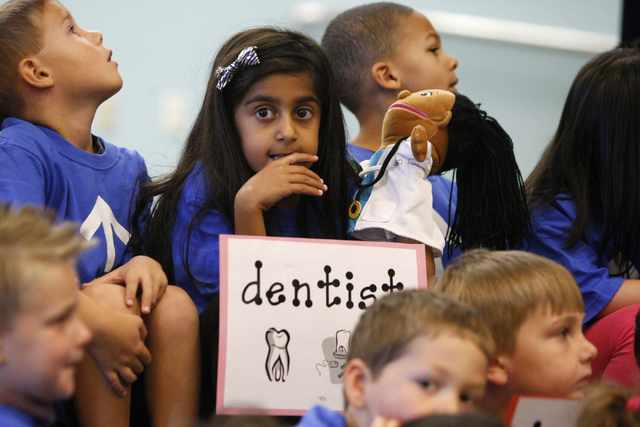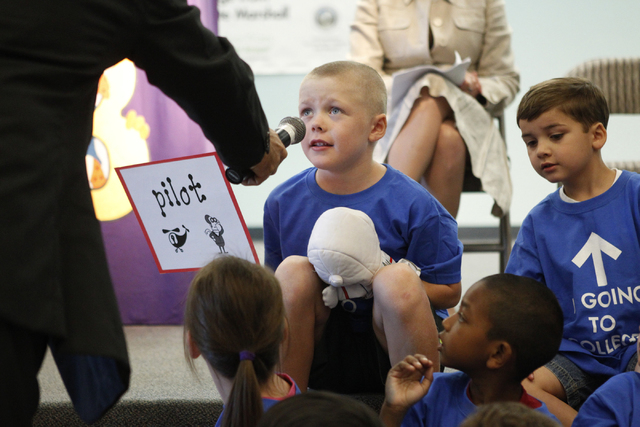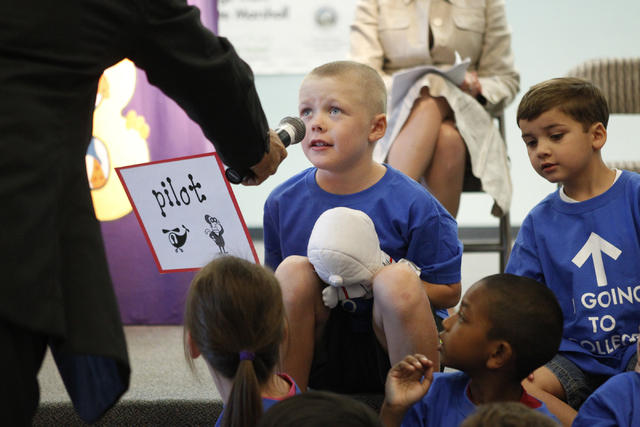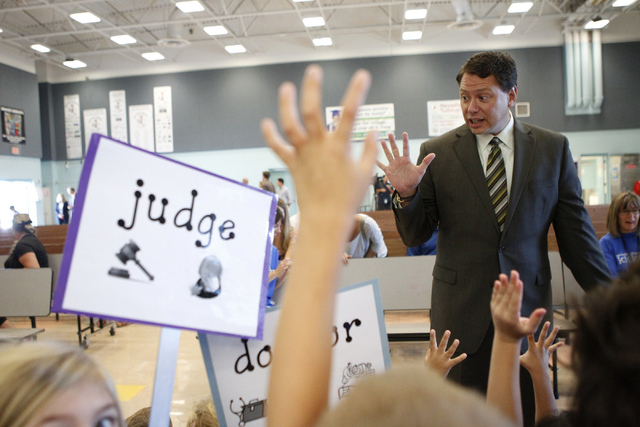Nevada treasurer plants college seed money in kindergarten





Every kindergartner in Nevada public schools now has a college savings account with a $50 balance.
The Nevada state treasurer’s office opened these 35,000 accounts and made the $1.8 million in deposits using no taxpayer money, repeating what it did last year for that kindergarten class of about the same size.
State Treasurer Kate Marshall knows the $50 — estimated to be $220 by the time these students graduate high school — isn’t much considering the cost of a four-year college. It’s more about planting a seed, said Marshall, referencing research that shows children with college-savings accounts are seven times more likely to attend college.
“You’re telling that child in a real tangible way, ‘You’re going to college,’” said Marshall at Bonner Elementary School, near Summerlin Parkway and Town Center Drive, announcing the continuation of Nevada’s College Kick Start program on Tuesday as she stood behind kindergartners wearing the same blue T-shirts.
The front of the shirts read “GOING TO COLLEGE” with an arrow pointing up to kindergartners’ faces. In the audience were their parents.
“I’m encouraging you to open a college savings account alongside it for your child,” said Marshall, highlighting her office’s other program requiring only $15 for families to open college-savings accounts, where deposits can be made at will. The state will match their deposits dollar for dollar up to $300 annually under the Silver State Matching Grant program, available to families with annual incomes of less than $75,000.
The separate Kick Start Program is midway through a three-year trial run. Whether it continues past next year’s kindergarten class will be up to the Nevada College Savings Board, said Marshall, chairwoman of the board.
“I hope the board continues this for every kindergarten class,” Marshall said. “The money’s there.”
The program is funded by fees the treasurer collects from financial institutions managing college-savings plans in Nevada, such as USAA, Vanguard, State Street and Putnam Investments. Donations are also accepted and can be directed to Kick Start accounts of specific schools, Marshall said.
While parents can’t add to their children’s Kick Start savings accounts, they’ll receive quarterly updates on the account balance and information on how to create an account they can control. When their child goes to college, the Kick Start money will be sent directly to the college or trade school of their choice, as long as it’s within five years of graduating high school.
But the Kick Start program needs to be successful to continue past next year. The best way to assess that — college-bound rates — won’t be known until these students graduate high school in 2026 through 2028. Therefore, the board will look to the rates at which they start college savings accounts of their own, shooting for 10 percent. The average rate nationwide is 3 percent.
Parents of 545 students have opened college-savings accounts out of the 34,000 students in the first Kick Start class, which amounts to 1.5 percent, Marshall said.
“To reach 10 percent would be phenomenal,” she said.
At least one parent, Jim Huff, was sold Tuesday. He’s also a third-grade teacher at Bonner and has a regular savings account for his daughter in kindergarten, Yolana.
“Why do we have that money sitting in the bank when we could put it to work?” said Huff, wowed by the promise of a $300 annual match if he creates a college-savings account.
While the success of the Kick Start program is still unknown, the state’s matching-grant program has been breaking records. During the 2014 application period of April 1 to June 31, the treasurer’s office received 414 applicants, a 62 percent jump from 2013. The program is also young, finishing its fifth year and handing out $67,000 in matching funds to 236 accounts last year.
All these efforts are being made for a reason, Marshall said. Less than a third of Nevada’s adults have an associate degree or higher, according to data reported by states to the nonprofit Complete College America. That’s a culture that needs to change, considering that 58 percent of jobs will require a college education by 2020, Marshall said.
“This (College Kick Start) program allows these children to see what their future can be,” Clark County School District Superintendent Pat Skorkowsky said at Bonner, one of 357 schools in the nation’s fifth-largest school district. “This is an amazing day. We are starting the future for these kids.”
The program is getting attention outside Nevada, too. State officials from Colorado and Connecticut have called the Nevada treasurer’s office for tips on how to run the program and fund it, Marshall said.
Contact Trevon Milliard at tmilliard@reviewjournal.com or 702-383-0279. Find him on Twitter: @TrevonMilliard.












